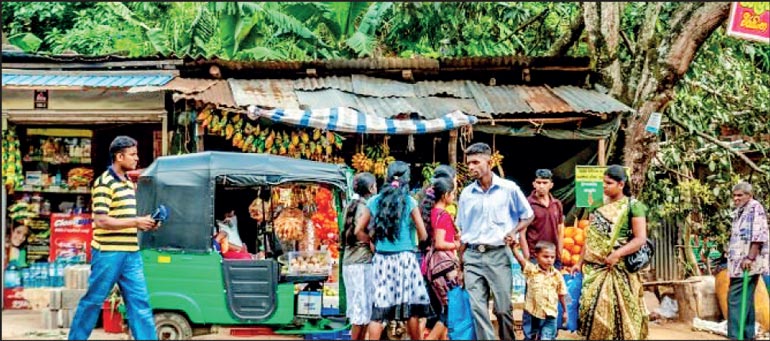Sunday Dec 14, 2025
Sunday Dec 14, 2025
Friday, 22 August 2025 00:00 - - {{hitsCtrl.values.hits}}

Social protection for individuals and households must be recognised not just as a safety net, but as an economically and socially empowering instrument that brings stability, prosperity and resilience
By Armida Salsiah Alisjahbana, Kanni Wignaraja and Fatima Yasmin
Asia and the Pacific is navigating multiple disruptions, both positive and negative. Economic restructuring, green transitions, intensifying climate change, demographic shifts and digital transformations are posing a critical question: how do we ensure that large numbers of people are not left behind?
One response is indispensable. Social protection for individuals and households must be recognised not just as a safety net, but as an economically and socially empowering instrument that brings stability, prosperity and resilience.
Across the region, many workers are already experiencing disruptions caused by intensifying climate risks, shifting job markets and deepening inequalities. These are not abstract threats; they frame existential livelihood challenges for hundreds of millions of people in the region.
This makes social protection imperative. Smartly designed and delivered, it can enable more inclusive economic progress in the short and medium term, leading to more resilient societies that can respond faster and more effectively to shocks. Effective social protection mechanisms keep households afloat for extended periods, allow workers to transition smoothly from brown to green jobs, support caregiving and old-age security, and give people the confidence to pivot to new skills, jobs and business ventures.
While over 50% of the region’s population is covered by at least one social protection benefit, slightly above the global average, coverage remains uneven, and protection is patchy. Work-related benefits remain critically low, with just 13.5% covered by unemployment insurance and only 30.5% of workers having workplace injury protection.
At the recent Fourth International Conference on Financing for Development in Sevilla, global leaders called for an increase in investment in social protection by at least two percentage points annually.
However, in some countries, social protection is still viewed as a cost rather than a strategic investment. This mindset must change. Social protection that is comprehensive and guided by updated, connected data systems delivers high returns and must be seen as a plus on the balance sheet.
Modelling and AI-driven social protection systems can now help reduce the rising costs of unemployment, pressure on health systems and negatives associated with societal dissatisfaction. This was evidenced during the pandemic, for example, when digital technologies helped support measures to reach the target groups. Today, AI is increasingly being used to obtain valuable insights from beneficiaries’ inquiries and enhance service delivery.
Governments must not wait for a crisis to act. Investing early in universal, inclusive and adaptive social protection systems makes for good economic, political, and social policy and practice.
We are already seeing promising impacts of improved social protection systems. In the Philippines, the Barangay Bay Environmental Cash for Work program compensated crew members of commercial fishing vessels who lost income during a fishing ban aimed at restoring fish stocks. To compensate, these workers received a wage in exchange for environmental protection work such as cleaning up beaches and canals.
In Indonesia, the Government provided cash transfers to low-income households. These transfers work to disincentivise the consumption of forest-sourced goods while encouraging purchases of goods in the market. India’s pioneering Rajasthan Platform-Based Gig Workers Act of 2023 targets the gig economy, establishing a welfare board and a dedicated social security fund financed by a levy on platform-based transactions.
Social protection and climate adaptation policies share the common goal of reducing vulnerability and building resilience. Governments can address both poverty and environmental goals by aligning social protection measures with the ongoing green transition. Countries moving towards this integration all count on sustained political will and leadership that sees the investment in people as central to their nations’ progress.
International partners can play a vital role in helping countries achieve these twin goals. Multilateral development banks and UN agencies can help governments design, finance and scale social protection systems, especially in low-income and climate-vulnerable contexts.
Our 2025 Asia-Pacific SDG Partnership Report highlights the need for targeted solutions to promote inclusive workforce development, emphasising that expanding social protection systems is essential to enabling just transitions to green and blue economies, particularly for the region’s most vulnerable populations facing complex and disruptive challenges.
These actions will help ensure the region does more than simply survive disruption. Prioritising social protection as a strategic investment for development will allow everyone to thrive as challenges are overcome.
(Armida Salsiah Alisjahbana is Under-Secretary-General of the UN and Executive Secretary of the UN Economic and Social Commission for Asia and the Pacific (ESCAP), Kanni Wignaraja is UN Assistant Secretary-General and Regional Director for Asia and the Pacific (UNDP), Fatima Yasmin is Vice President Sectors and Themes, Asian Development Bank (ADB).)